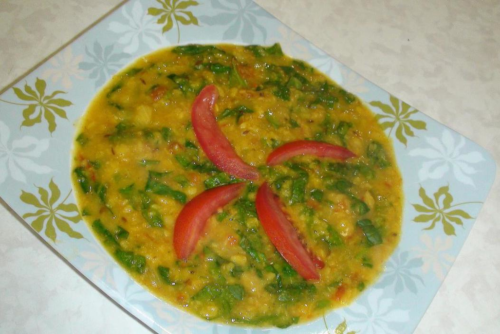Mama’s Punjabi Recipes – Sabat Moong te Palak di Daal (SPINACH & WHOLE MOONG LENTILS)
 Daals are the mainstay of the Indian diet, whether you are in the north or south, east or west – providing much needed protein, especially for the multitude of vegetarians in the country – and each region has its own way of making them. So central are they to Indian life, there is even a phrase to express daily life: “daal-roti toh khani hai” (we have to eat our daily bread). But nowhere will you find the heartiness and flavorful taste of daals as you would in the Punjab.
Daals are the mainstay of the Indian diet, whether you are in the north or south, east or west – providing much needed protein, especially for the multitude of vegetarians in the country – and each region has its own way of making them. So central are they to Indian life, there is even a phrase to express daily life: “daal-roti toh khani hai” (we have to eat our daily bread). But nowhere will you find the heartiness and flavorful taste of daals as you would in the Punjab.
Punjabi daals are known for their smooth, thick texture and the perfect blend of spices. They are not supposed to be runny or thin and the hot tardka or blending in of spices, onions, garlic and sometimes hing (asafoetida) is a sizzling experience that fills the air with the aroma of the dish.
To this day, in the majority of rural communities and in many traditional recipes, daal is cooked in a large patila (pot) simmered over a slow to medium flame. Daal should be cooked so that you can spot the grain and have a little turri (curry). Too thick or too thin a daal and you can’t scoop it with roti (flat bread).
The dish is made with leafy, dark green spinach, which is rich in vitamins A, B2, B6, C, E, K, magnesium, folate, manganese, iron, calcium and potassium. It’s a very good source of protein, phosphorus, zinc, dietary fiber, and copper as well as selenium, niacin, and omega-3 fatty acids. Spinach and methi (fenugreek) are sometimes added selectively to some daals to enhance their flavor and appeal.
Sabat (whole) moong daal is leaf green in color and the dark spinach and soya leaves give the dish a nice dual look and added flavor. This dish cooks fairly fast and goes especially well with hot rotis.
Ingredients:
• 1 cup sabat moong daal (whole moong lentils)
• 500 gm palak (spinach)
• 2 cups pani (water)
• 2 tbsp olive oil
• 4 cloves of lasan (garlic) – peeled and chopped
• 1 medium adrak (ginger) – peeled and chopped
• 2 hari mirch (green chillies) – medium and chopped
• 1/2 cup soya patta (soya leaves) (optional)
• 5 stalktops fresh dhania (coriander) – pinch off the leaves and cut into pieces
• 1 tsp garam masala
• Spices (to taste): lal mirch (red pepper); namak (salt); haldi (turmeric)
Directions:
1. Carefully wash the spinach leaves thoroughly to remove any dirt, drip to dry then cut the leaves into half inch pieces.
2. Place the moong daal in a bowl and wash it thoroughly in cold water, then rinse it out.
3. Bring the 2 cups of water to a boil over high heat. Pour in the moong daal into the pot, cover, and add the cut spinach, soya patta, haldi, ginger, green chilies and salt and let it come to a second boil then reduce the heat to medium.
4. If the water boils off before the daal becomes tender, then add some more and let it continue to boil for about 30 minutes till the daal is tender but not soft. Keep a frequent eye on the daal to make sure it does not become soupy.
5. Heat the oil in a small karai or wok and add the garlic and brown it a little. When roasted and the smell of the pieces starts to come through, take off the heat and drop the masala into the pot of cooked daal and stir to mix well.
6. Sprinkle the top of the daal with garam masala and the cut coriander leaves above.
MAMA’S TIP OF THE WEEK: IF ON A LOW SUGAR DIET, USE HONEY INSTEAD
Many people on a restricted, low sugar diet cut back on many of the foods they love and skip many deserts or drinks and cookies of all types. Though they are mindful of what they eat, it is difficult not to crave for carbohydrate foods which are crunchy and satisfying.
Honey is often used as a substitute for sugar, mixed in hot drinks and also when used with lemon juice as a tonic against the common cold. But for those who want cookies, a few made with honey are available.

Shakuntla Malhotra is a skilled cook of Punjabi dishes made in the old-fashioned style that she learnt as a young woman in her ancestral home in Lyallpur, India (since renamed Faisalabad) before it became part of Pakistan after the Partition in 1947. People have often admired her cooking for its simplicity and taste that comes with each mouthful. Even in her late-eighties, she continues to cook daily and agreed to share her delectable Punjabi recipes for future generations.
